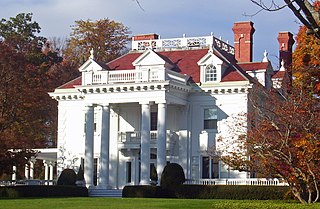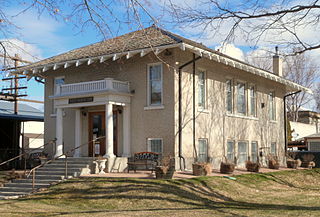
The Arcola Carnegie Public Library is a Carnegie library located at 407 E. Main St. in Arcola, Illinois. The library was built in 1905 through a $10,000 grant from the Carnegie Foundation. Architect Paul O. Moratz designed the library in the Classical Revival style. The building's front entrance is situated within a Classical gabled portico supported by stone pilasters. The hipped roof of the building features an ornamental cornice along its edge and a cupola at its peak. The building still serves as Arcola's public library and houses a collection of over 18,000 books.

The Aitkin Carnegie Library is a Carnegie library in Aitkin, Minnesota, United States. It was designed by architects Claude & Starck and was built in the Classical Revival style. It was listed on the National Register of Historic Places in 1982.

The Waldo Theatre is a historic movie theater and performance venue at 916 Main Street in Waldoboro, Maine. Built in 1936 as a movie theater to a design by New York City architect Benjamin Schlanger, it was hailed at the time as one of the best-designed state-of-the-art small theaters in the country. It is now managed by a non-profit arts organization. It was listed on the National Register of Historic Places in 1986.

The Battle House Hotel, now known as The Battle House Renaissance Mobile Hotel & Spa, is a historic hotel building in Mobile, Alabama. The current building was built in 1908 and is the second hotel to stand in this location, replacing an earlier Battle House that was built in 1852 and burned down in 1905. It is one of the earliest steel frame structures in Alabama.

Hiddenhurst is the former estate of businessman Thomas Hidden, on Sheffield Hill Road in the Town of North East, New York, United States, south of the village of Millerton. It is an elaborate frame house built at the beginning of the 20th century in the neo-Georgian architectural style.

Humboldt Public Library in Humboldt, Iowa, USA, is a free public library. The library received a $10,000 grant from the Carnegie Corporation of New York on December 13, 1906. The Des Moines architectural firm of Hallett & Rawson designed the building. It was built using limestone from a nearby area now known as Taft Park. Construction began in 1908 and it was dedicated on February 9, 1909. The rough texture of the rock-faced stone and the portico columns in the Tuscan order give the building a rustic appearance. It was listed on the National Register of Historic Places in 1983. A north entrance and extension were added to the building in 1992.

The John Kendrick House is located on West Main Street in Waterbury, Connecticut, United States. It is a brick Tuscan villa house in the Italianate architectural style built in the 1860s, one of the last remaining on Waterbury Green from that period, after which many of the older houses were replaced with commercial buildings. In 1982 it was listed on the National Register of Historic Places individually, after having been included as a contributing property when the Downtown Waterbury Historic District was created a few years earlier.

The Paulding County Carnegie Library is a historic Carnegie library in the village of Paulding, Ohio, United States. Constructed in the early twentieth century, it is a simple building that has served as the core of Paulding County's library system since its construction, and it has been designated a historic site.

The Escanaba Public Library was a Carnegie library located at 201 South Seventh Street in Escanaba, Michigan. It was listed on the National Register of Historic Places in 1977 and designated a Michigan State Historic Site in 1976.

The Middleport Public Library is a historic Carnegie library in the Ohio River village of Middleport, Ohio, United States. Built in the early twentieth century, it has been named a historic site.

Edgemont, also known as Cocke Farm, is a historic home located near Covesville, Albemarle County, Virginia. It was built about 1796, and is a one- to two-story, three bay, frame structure in the Jeffersonian style. It measures 50 feet by 50 feet, and sits on a stuccoed stone exposed basement. The house is topped by a hipped roof surmounted by four slender chimneys. The entrances feature pedimented Tuscan order portico that consists of Tuscan columns supporting a full entablature. Also on the property is a rubble stone garden outbuilding with a hipped roof. The house was restored in 1948 by Charlottesville architect Milton Grigg (1905–1982). Its design closely resembles Folly near Staunton, Virginia.

The historic Duluth Public Library is a former Carnegie library building at 101 West Second Street in Duluth, Minnesota, United States. It was constructed in 1902 as the first purpose-built facility of the Duluth Public Library. It was listed on the National Register of Historic Places in 1978 for its local significance in the themes of architecture and education. It was nominated for its Neoclassical architecture and association with early community education efforts.

The Hoopeston Carnegie Public Library is a Carnegie library located at 110 N. Fourth St. in Hoopeston, Illinois. Hoopeston's library program began in 1898, when the Mary Hartwell Catherwood Club started a library in the town hall. In 1903, the program acquired a $12,500 grant from the Carnegie Foundation for a library building; the building was completed in 1904. Architect James F. Alexander designed the Classical Revival building, which features a portico entrance supported by four Tuscan columns. In 1975, an addition was placed on the building.

The Hanover Town Library, also known as the Etna Library, is a historic branch library located at 130 Etna Road in Hanover, New Hampshire, United States. It serves the Etna section of the town; the Classical Revival building it occupies was the first purpose-built library building in the town, and is listed on the National Register of Historic Places. It is a modest brick building, designed by Dartmouth College professor Robert E. Fletcher and built in 1905.

The Jacksonville Public Library is a Carnegie library located at 201 West College Avenue in Jacksonville, Illinois. The library was built in 1902 to house the city's library program, which began in 1870. Chicago architects Patton & Miller designed the Classical Revival building. The building still houses the city's public library and is listed on the National Register of Historic Places.

The Kewanee Public Library is a Carnegie library located at 102 South Tremont Street in Kewanee, Illinois. The library was built in 1907-08 to house the city's public library, which was formed in 1875 and had previously occupied a room in the town hall. The city's first attempt at building a Carnegie library came in 1901, but it could not secure funding to match Carnegie's $20,000 grant; later in the decade, it approved additional community funding and convinced Carnegie to supply an additional $5,000. Chicago architects Patton & Miller, who were well known for their work on Carnegie libraries, designed the Classical Revival building. The library's design includes an entrance flanked by four stone columns and topped by a portico, stone pilasters to either side of the front windows, and a classical entablature with a frieze and dentillated cornice.

Chariton Public Library is located in Chariton, Iowa, United States. The Library and Reading Room Association was formed in Chariton in 1879, but it was short-lived. The county superintendent of schools started a teachers' library in the courthouse sometime afterward. By this time the community had a library of 800 volumes. There was an effort by study clubs in town in 1898 to raise money and establish a free public library. The Chariton Federation of Women's Clubs took the lead and opened a library with the books from the courthouse in two rooms above Gibbons Drug Store on the town square. Citizens approved a local tax to support the library the following year.

The College View Public Library is a historic building in Lincoln, Nebraska. It was built as a Carnegie library with a $7,500 grant from the Carnegie Corporation in 1914, and designed in the Classical Revival style, with "a symmetrical front facade, simple brick corner pilasters, a water table and wall cornice, and a pedimented entrance enframed by Roman Ionic columns in Aritis." It has been listed on the National Register of Historic Places since June 28, 1984.

The James B. Staker House, or Staker House, at 211 N. State St. in Mount Pleasant, Utah, was built around 1880. It was listed on the National Register of Historic Places in 1980.

The Mountain Home Carnegie Library, at 180 S. 3rd St. East, in Mountain Home, Idaho, was built as a Carnegie library in 1908. It was listed on the National Register of Historic Places in 1978.






















